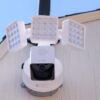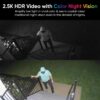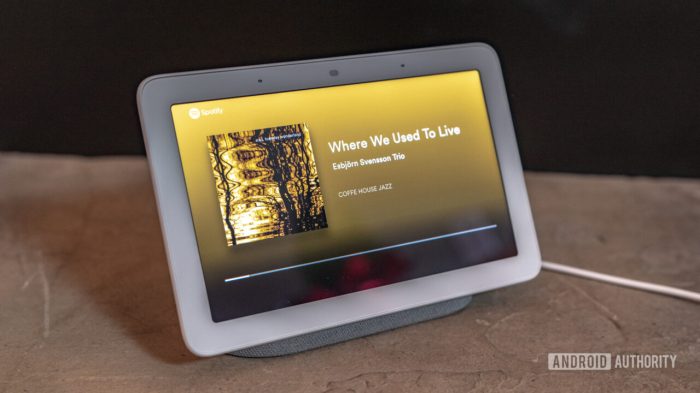Google Nest Hub vs Amazon Echo Show: Navigating the smart display landscape can feel overwhelming. Both devices offer voice control, smart home integration, and a plethora of apps, but which one truly reigns supreme? This in-depth comparison will explore the nuances of design, features, user experience, and pricing to help you decide which smart display best suits your needs.
This comparison dives into the heart of the matter, examining the key differences between these popular smart displays. We’ll analyze everything from screen size and resolution to voice assistant capabilities and smart home compatibility.
Introduction to Smart Displays
Smart displays, encompassing devices like the Google Nest Hub and Amazon Echo Show, have rapidly evolved from niche products to ubiquitous home technology. These interactive screens seamlessly blend entertainment, information access, and smart home control, offering users a convenient and often indispensable tool for everyday tasks. Their ability to respond to voice commands and display visual information has redefined how we interact with technology within our homes.The early days of smart displays were characterized by rudimentary interfaces and limited functionality.
These initial models primarily focused on basic tasks like playing music, setting alarms, and providing weather updates. However, rapid advancements in voice recognition, processing power, and display technology have led to the sophisticated smart displays we see today. These displays can now perform complex tasks, manage calendars, provide real-time information, and control smart home devices with ease.
Core Functionalities and Use Cases
Smart displays offer a wide range of functionalities beyond simple entertainment. Their primary functions revolve around voice interaction, visual display, and smart home integration. Users can control various aspects of their homes through voice commands, including adjusting lights, managing thermostats, and monitoring security systems. They serve as hubs for information retrieval, providing news, weather updates, and scheduling information directly to the user.
Moreover, their visual capabilities enable users to watch videos, stream music, and access various apps, transforming the display into a versatile entertainment center.
Evolution of Smart Displays
The development of smart displays mirrors the broader evolution of technology. Early prototypes, often featuring clunky interfaces and limited processing power, laid the foundation for today’s sleek and sophisticated devices. Improvements in voice recognition algorithms have dramatically increased accuracy and speed, allowing for more natural and intuitive user interactions. The rise of cloud-based services has expanded the range of information and entertainment accessible through these devices.
Advancements in display technology, including higher resolutions and touch responsiveness, have enhanced the overall user experience.
Technological Advancements
Several key technological advancements have propelled the evolution of smart displays. Significant improvements in voice recognition technology have enabled more accurate and natural voice commands. Increased processing power allows for faster response times and more complex functionalities. The integration of cloud services has unlocked access to vast amounts of information and entertainment. Improvements in display technology have led to higher resolution screens and more responsive touch interfaces.
Furthermore, the miniaturization of components has allowed for the development of more compact and aesthetically pleasing designs.
Comparison of Smart Display Features
| Feature | Description | Example (Google Nest Hub/Amazon Echo Show) |
|---|---|---|
| Screen Size | The size of the display, measured in inches. | Google Nest Hub: Typically 7 inches, Echo Show: Ranges from 5 to 10 inches |
| Processing Power | The computational capacity of the device, influencing response time and app performance. | Both offer adequate processing power for basic tasks, with differences in handling more demanding applications. |
| Connectivity Options | Wi-Fi, Bluetooth, and other network connections available for device communication. | Both utilize standard Wi-Fi and Bluetooth connectivity, allowing integration with various smart home devices. |
| Voice Recognition | The accuracy and speed of voice command processing. | Both boast high accuracy in voice recognition, with minor variations in performance based on user accent and environment. |
| Smart Home Integration | The ability to control and manage connected devices in the home. | Both are well-integrated with various smart home platforms and ecosystems. |
Google Nest Hub vs. Amazon Echo Show
Smart displays, like the Google Nest Hub and Amazon Echo Show, are becoming increasingly popular for their integration of voice assistants, screens, and various functionalities. Choosing the right one often boils down to specific needs and preferences. This comparison delves into the design, hardware, user interface, and connectivity of these two devices.
Design Aesthetics
The Google Nest Hub boasts a minimalist, rounded design, often described as sleek and unassuming. The Amazon Echo Show, on the other hand, comes in a more visually striking form factor, featuring a rectangular screen that sits atop a cylindrical base. These differing aesthetic choices cater to varying tastes, with the Nest Hub appealing to those who value simplicity, and the Echo Show to those who want a more visually prominent display.
Hardware Specifications
The hardware specifications of these smart displays play a crucial role in their functionality. A detailed comparison includes screen size, resolution, speaker quality, and camera capabilities.
- Screen Size and Resolution: The Google Nest Hub usually offers a smaller screen size compared to the Echo Show, typically around 7 inches. The Amazon Echo Show generally provides a larger screen, ranging from 8 to 10 inches. Resolution also varies, with the Echo Show often featuring higher pixel density for a sharper image. This difference in screen size and resolution directly impacts the visual experience and potential for displaying more content simultaneously.
- Speaker Quality: Both devices include built-in speakers for audio output. However, the Echo Show’s speakers often receive higher praise for their clarity and volume. The Nest Hub’s audio quality is acceptable for basic tasks but might fall short when compared to the Echo Show for richer sound experiences. Factors such as room acoustics and audio processing influence the perceived quality.
- Camera Capabilities: Both devices have integrated cameras for video calls and interactions. The camera quality varies, with the Echo Show sometimes boasting slightly higher resolution or better low-light performance. These camera features are vital for video calls, making a difference in clarity and picture quality during virtual interactions.
User Interface Differences
The user interface (UI) is a significant aspect of the user experience. The Google Assistant and Alexa, the respective voice assistants, differ in their functionalities and navigation. The user interface design also plays a significant role.
- Navigation: Navigating through the Google Nest Hub interface typically feels more intuitive and focused on the visual elements. The Amazon Echo Show interface, while functional, might present a slightly different user flow, requiring adjustments to find the desired information. Both devices have their strengths and weaknesses in terms of UI design and navigation efficiency.
- App Compatibility: Both devices support various apps, but compatibility and functionality can differ. The availability of apps relevant to user needs is a crucial aspect of evaluating smart display capabilities. This compatibility is vital for maximizing the device’s potential.
Connectivity Options
The connectivity options supported by each device are crucial for integrating them into a home network.
| Feature | Google Nest Hub | Amazon Echo Show |
|---|---|---|
| Wi-Fi | Supports standard Wi-Fi protocols | Supports standard Wi-Fi protocols |
| Bluetooth | Supports standard Bluetooth protocols | Supports standard Bluetooth protocols |
| Other Protocols | May support other protocols, like NFC | May support other protocols, like NFC |
- Connectivity Overview: Both devices offer standard Wi-Fi and Bluetooth connectivity. Additional protocols like NFC might be present but are not consistently highlighted. The availability of these protocols determines how seamlessly the device integrates into existing home networks and devices.
Functionality and Features: Google Nest Hub Vs Amazon Echo Show
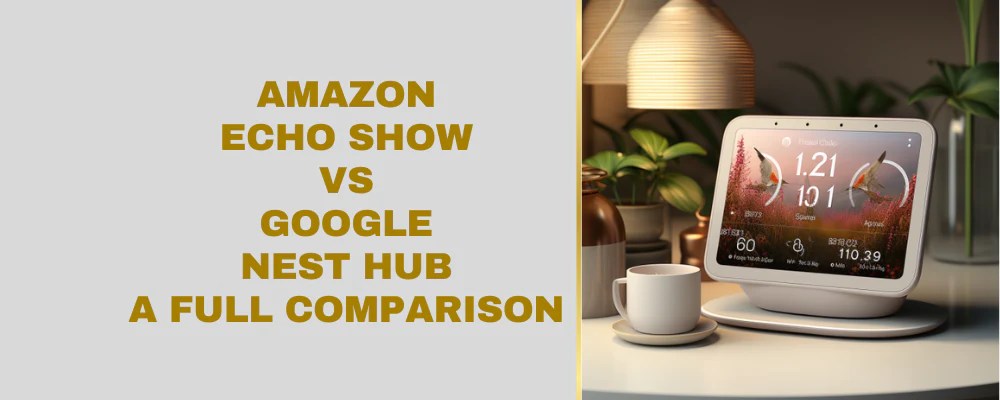
Smart displays like the Google Nest Hub and Amazon Echo Show are rapidly becoming central hubs for modern homes. Beyond basic functionalities, these devices offer a rich array of features for managing daily tasks, interacting with smart homes, and accessing information. This section dives into the core functionalities, comparing their strengths and highlighting their unique capabilities.The core strength of these devices lies in their seamless integration with various smart home ecosystems.
They allow users to control lighting, thermostats, security systems, and other connected devices through voice commands, providing a hands-free approach to home automation. This section will delve into the smart home integration capabilities of each device, examining their voice assistant functionalities, and their control accuracy.
Smart Home Integration
Both Google Nest Hub and Amazon Echo Show excel at controlling smart home devices. They support a wide range of compatible products, allowing users to manage their entire smart home ecosystem with ease. However, their support for different brands and protocols can vary. This necessitates careful consideration of existing smart home setups when choosing a device.
- Google Nest Hub’s integration with Google Home ecosystem provides a streamlined experience for managing devices from a single platform. This seamless integration is a key advantage for users already invested in the Google ecosystem.
- Amazon Echo Show’s compatibility with Amazon’s Alexa ecosystem offers similar control over a broad range of smart home devices. The vast range of compatible devices is a significant plus, especially for users who might have a mixture of smart home products from various brands.
Voice Assistants and Capabilities
The voice assistant is the core of these smart displays. Comparing Google Assistant and Amazon Alexa reveals subtle yet significant differences.
- Google Assistant’s strength lies in its integration with Google services. This includes seamless access to Google Search, Calendar, Maps, and other Google apps. Its strengths extend to its compatibility with a growing range of third-party apps.
- Amazon Alexa’s strengths are its extensive library of skills and its ability to handle various tasks. The vast number of third-party skills available is a crucial feature, especially for those seeking specific functionalities beyond the basic smart home controls.
Voice Control Accuracy and Limitations
Voice control is a key feature, but accuracy and limitations exist.
- Both devices demonstrate high accuracy in recognizing voice commands, though environmental factors like background noise can impact performance. This is a common challenge for all voice-activated devices.
- Limitations in voice control include difficulty in understanding complex commands or accents that deviate significantly from the trained datasets. This highlights the ongoing need for refinement in voice recognition technology.
App and Feature Comparison
The following table summarizes the available apps and features on each device, categorized for easy comparison.
| Feature | Google Nest Hub | Amazon Echo Show |
|---|---|---|
| Smart Home Control | Excellent integration with Google Home devices; comprehensive control | Robust integration with Alexa ecosystem; wide compatibility |
| Voice Assistant | Google Assistant; strong search and information retrieval | Alexa; extensive skill library and functionality |
| Video Calling | High-quality video calls through Google Duo | High-quality video calls through Alexa calling |
| Media Playback | Stream music, podcasts, and videos from various services | Stream music, podcasts, and videos from various services |
| Display Features | Clear display; good for displaying information and timers | Large screen; suitable for video calls and displaying content |
User Experience and Interface
The user experience (UX) is a critical factor when choosing between smart displays. A well-designed interface can make interacting with the device intuitive and enjoyable, while a cumbersome one can lead to frustration. This section delves into the distinct user interface designs, ease of use, navigation, and interaction patterns of the Google Nest Hub and Amazon Echo Show, focusing on how they perform common tasks.The Google Nest Hub and Amazon Echo Show, despite similar functionalities, employ contrasting UI approaches, influencing the overall user experience.
Understanding these differences can help users choose the device that best suits their needs and preferences.
Comparing Google Nest Hub and Amazon Echo Show? It’s a tough call, really. Both offer smart features, but recent news about the potential price hike for certain Galaxy S25 Edge models might surprise some. Ultimately, the best choice depends on individual needs and budget, but hopefully, the smart home options remain affordable! Looking at the features and considering the recent price news, I’m leaning towards the Nest Hub for my next purchase.
Interface Design Differences
The Google Nest Hub leans towards a simpler, more streamlined interface. Its design prioritizes a clean aesthetic, featuring a more minimalist approach. In contrast, the Amazon Echo Show, while functional, tends to be slightly more visually complex, with various elements and information displayed more prominently on the screen. These design differences affect the way users interact with each device.
User Experience and Ease of Use
The Google Nest Hub’s intuitive interface and streamlined design contribute to a smoother user experience, particularly for those new to smart displays. The Amazon Echo Show, with its slightly more complex layout, might require a bit more time for users to become comfortable. Overall, both devices are generally user-friendly.
Navigation and Interaction Patterns
Navigation on the Google Nest Hub is accomplished through simple touch gestures and voice commands. The layout is more straightforward, making it easy to locate desired functions. The Amazon Echo Show utilizes a similar voice command system, but its on-screen menus might involve slightly more tapping and scrolling for specific actions.
Comparison of Basic Tasks
Setting alarms on both devices is straightforward. Controlling smart home devices is also easily accomplished through their respective interfaces. Making calls using both platforms involves a comparable level of simplicity.
Navigation Methods Effectiveness
| Feature | Google Nest Hub | Amazon Echo Show |
|---|---|---|
| Setting Alarms | Simple touch-based interface, quick and efficient | Intuitive voice commands and on-screen options |
| Smart Home Control | Clear and concise interface, quick access to devices | Multiple ways to control devices, slightly more steps |
| Making Calls | Simple touch interface for initiating calls | Voice command and on-screen options for calls |
| Overall Navigation | Fast and efficient, intuitive layout | Slightly more complex layout, but functional |
| Effectiveness | High, due to its simplicity and directness | High, despite slight complexity, due to options available |
The table above summarizes the navigation methods and their effectiveness for both devices in performing basic tasks.
Price and Availability
Smart displays, like the Google Nest Hub and Amazon Echo Show, offer a wide range of features at various price points. Understanding the pricing tiers and regional availability is crucial for consumers seeking the best value for their needs. The availability and pricing often fluctuate based on market demand and retailer promotions.The varying configurations of these devices, including screen size, built-in features, and included accessories, directly impact the price.
Different models cater to diverse budgets and preferences.
Ever wondered which smart display reigns supreme, the Google Nest Hub or the Amazon Echo Show? While both offer similar features, the tech landscape is evolving rapidly. Just like the Quest 2 and PSVR 2 are symbiotic rivals in the virtual reality space, pushing each other to innovate, quest 2 psvr 2 are symbiotic rivals , the smart display market is seeing a similar dynamic.
Ultimately, the best choice often depends on your specific needs and preferences, but both companies are constantly improving their offerings to stay competitive in this exciting arena.
Pricing Tiers and Configurations
Different models of both Google Nest Hub and Amazon Echo Show offer varying features and prices. The Nest Hub often comes in smaller screen sizes with fewer integrated functionalities compared to the Echo Show. Conversely, Amazon’s Echo Show lineup tends to feature larger screens and often more advanced features, leading to a higher price point. For example, the Nest Hub (2023) models generally have lower starting prices than their Echo Show counterparts.
Choosing between the Google Nest Hub and the Amazon Echo Show can be tricky. Both offer smart features, but the recent advancements in AI, like the creation of new Beatles music using AI now and then the beatles new song ai , show how far the technology has come. Ultimately, the best choice depends on your specific needs and how you plan to use these smart displays in your daily life.
The Google Nest Hub may offer better integration with other Google products, while the Amazon Echo Show might suit those who already have a robust Amazon ecosystem.
Regional Availability
The availability of smart displays differs across various regions due to factors like import restrictions, local market demands, and retailer partnerships. For example, a specific model might be exclusive to a particular market or region. The availability of accessories and software updates might also vary regionally.
Price and Availability Summary
| Region | Google Nest Hub (Example Model) | Amazon Echo Show (Example Model) | Availability Notes |
|---|---|---|---|
| United States | $49.99 – $129.99 | $99.99 – $229.99 | Widely available at major retailers. Various models are often available for purchase at discounted rates or with bundles. |
| United Kingdom | £49.99 – £129.99 | £99.99 – £229.99 | Widely available at major retailers and online marketplaces. |
| India | ₹3,999 – ₹8,999 | ₹6,999 – ₹14,999 | Availability is dependent on the retailer and may vary in different parts of the country. |
| Japan | ¥8,980 – ¥19,980 | ¥12,980 – ¥29,980 | Widely available at major electronics retailers. Local language support and features are often available. |
Note: Prices and availability are examples and may vary based on the specific model, retailer, and time of purchase.
Customer Reviews and Feedback
Unveiling the nuanced perspectives of users provides valuable insights into the strengths and weaknesses of both the Google Nest Hub and the Amazon Echo Show. Analyzing customer feedback allows for a deeper understanding of user experiences, enabling informed comparisons and highlighting areas for potential improvement. This section dives into the positive, negative, and neutral sentiments expressed by customers, shedding light on the overall user experience with each device.
Summary of Customer Reviews, Google nest hub vs amazon echo show
Customer reviews offer a diverse spectrum of opinions, reflecting varying needs and preferences. Positive reviews often highlight specific features appreciated by users, while negative feedback frequently centers on issues like performance, functionality, or user interface. Neutral reviews frequently offer balanced perspectives, acknowledging both positive and negative aspects. Examining these different types of feedback allows for a comprehensive evaluation of the products’ strengths and weaknesses.
Positive Customer Feedback
A significant portion of customer reviews for both devices expresses appreciation for their ease of use. Users often praise the intuitive interfaces, simple setup processes, and the quick response times of both devices. The positive aspects extend to their versatility in performing everyday tasks like playing music, setting alarms, or making video calls.
Negative Customer Feedback
Several negative reviews mention issues with the screen quality, particularly regarding viewing angles or resolution, especially noticeable in brightly lit environments. Connectivity problems and software glitches are also recurring complaints, highlighting the need for reliable performance. Limited smart home integration capabilities, especially when compared to other smart home ecosystems, have been cited as a drawback in some customer reviews.
Neutral Customer Feedback
Neutral reviews frequently acknowledge the devices’ strengths and weaknesses, often emphasizing that the products’ value depends on individual needs and usage patterns. Users might appreciate the affordability of the products but acknowledge some shortcomings. A common thread in neutral reviews is the comparison of the products to each other, noting the pros and cons of each, in order to support a balanced and objective evaluation.
Strengths and Weaknesses Based on Feedback
| Feature | Google Nest Hub | Amazon Echo Show |
|---|---|---|
| Ease of Use | Generally praised for its intuitive interface and simple setup. | Often lauded for its user-friendly interface and straightforward operation. |
| Screen Quality | Some users report issues with viewing angles and resolution in bright lighting. | Similar reports of screen quality issues in certain lighting conditions. |
| Connectivity | Occasional connectivity problems are noted, though usually less frequently than issues with screen quality. | Similar connectivity problems noted, sometimes attributed to specific Wi-Fi environments. |
| Smart Home Integration | Positive feedback for integration with Google Assistant ecosystem but mixed opinions regarding broader smart home compatibility. | Strong integration with Amazon ecosystem is often praised but sometimes seen as less adaptable to other smart home platforms. |
| Price | Often cited as a positive aspect, making it attractive to budget-conscious consumers. | Similarly considered a positive factor for price-sensitive buyers. |
Future Trends and Predictions
Smart displays, like the Google Nest Hub and Amazon Echo Show, are rapidly evolving. Anticipating future advancements is crucial for understanding their potential impact on daily life and the broader technology landscape. The convergence of artificial intelligence, voice assistants, and ever-improving hardware is driving this transformation. We can expect a continued push toward more intuitive and personalized user experiences.The next generation of smart displays will likely incorporate more sophisticated visual capabilities, offering enhanced user interaction and information delivery.
We can anticipate a blend of seamlessly integrated features, pushing beyond the current boundaries of voice control and visual interfaces. This evolution will be heavily influenced by emerging technologies and user feedback.
Hardware Advancements
The quest for improved hardware is paramount. Smart displays will likely see advancements in screen technology, leading to higher resolutions, wider viewing angles, and more vibrant colors. Improved touch response and durability are also key. OLED displays, known for their energy efficiency and contrast, are likely candidates for future iterations. The inclusion of integrated cameras with enhanced image quality and advanced object recognition capabilities is also anticipated.
This will allow for more nuanced interactions and a wider range of functionalities. Increased processing power will enable more complex applications and smoother multitasking.
Software Innovations
Software enhancements will play a critical role in shaping the future of smart displays. Improved natural language processing (NLP) will translate even more complex user queries into actionable commands. Enhanced AI-driven personalization will cater to individual user preferences, learning and adapting to habits over time. Integration with smart home ecosystems will be even more seamless, enabling more sophisticated control and automation.
Enhanced security measures, protecting user data and privacy, are crucial considerations.
Emerging Technologies
Emerging technologies like augmented reality (AR) and virtual reality (VR) will likely influence smart displays. Imagine overlaying information from the real world onto the screen, or experiencing interactive content through a virtual environment. The integration of these technologies will offer immersive and engaging experiences, transforming how users interact with the display.
Future Features and Functionalities
The possibilities for future features and functionalities are extensive. Smart displays could integrate advanced health monitoring capabilities, offering users personalized insights and potentially linking with wearables. Enhanced entertainment options, such as high-quality video streaming and interactive gaming, are also probable. More advanced educational tools and interactive learning experiences are likely to emerge, making learning more engaging and accessible.
The development of advanced productivity tools, tailored for specific user needs, is another plausible direction.
Predicted Future Advancements
| Feature | Predicted Advancement |
|---|---|
| Screen Technology | Higher resolution, wider viewing angles, improved color accuracy, integration of OLED or micro-LED technology. |
| Processing Power | Increased processing power for smoother multitasking, more complex applications, and advanced AI functionalities. |
| User Interface | More intuitive and personalized user interfaces, leveraging advanced NLP and AI for more natural interaction. |
| Integration with Smart Home | Seamless integration with a wider range of smart home devices, allowing for more sophisticated control and automation. |
| Additional Features | Health monitoring, enhanced entertainment options, advanced educational tools, and specialized productivity tools. |
Closing Notes
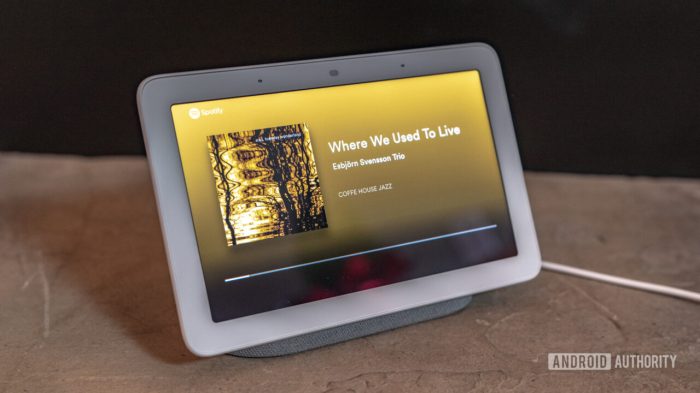
In conclusion, both the Google Nest Hub and Amazon Echo Show offer compelling features for smart home integration and entertainment. Ultimately, the best choice depends on your individual needs and preferences. Consider factors like screen size, design, app availability, and the specific smart home ecosystem you’ve already established. This comparison should equip you with the insights necessary to make an informed decision.

